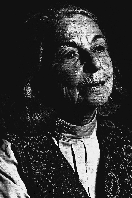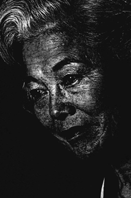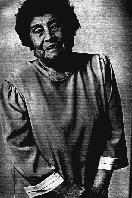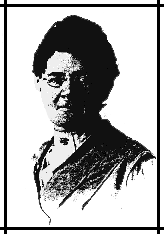Utah Centennial Studies

Simple Gifts...Personal Contributions To Utah Packet B
- HILDA PARKER: BEYOND SURVIVAL
- CHIEKO OKAZAKI: BUILDING BRIDGES
- BERTA MAYER: CROSSING THE TRACKS
- DR CANNON, I PRESUME?
By Jane Chapman Martin Photography by Brett Colvin
Quiet courage can be difficult to mark. Too often, we immortalize the high-wattage star power of popular culture: entertainers and movie stars, athletes and politicians. Even in a season when we remember our war heroes, there are few flag-waving ceremonies set aside for the kind of power that builds communities. Strong mothering, for example, or surviving the cruelty of racial hatred, or gracefully overcoming tragedy.
Here are three Utahans who have woven together remarkable lives. They come from different cultures but are alike in their devotion to community, to religion, to education. to children. These are the kind of Americans who don't seek out headlines, who aren't commemorated with rituals or ceremony. But because of their rare vision and their remarkable triumphs, Hilda Parker, Chieko Okazaki and Berta Mayer can be counted among the strongest of our American heroes.
 HILDA
PARKER: BEYOND SURVIVAL
HILDA
PARKER: BEYOND SURVIVAL
Hilda Parker listened closely to the man who came into her barracks with the SS officer. Speaking in German, the man told the Nazi soldier he needed intelligent women for a project.
Hilda thought quickly. She had learned to keep quiet in the year she had been imprisoned at Auschwitz, and no one knew she and her friends from Czechoslovakia spoke fluent German. But she realized that the chosen women would probably be allowed to live. Turning to her friends, she told them now was the time to speak their best German. When the two men questioned them, the Czech teenagers answered clearly: they were students, or teachers, or professionals.
Ten days later, the girls were put on a train to a work camp just outside Czechoslovakia, rare survivors of the deadliest of Nazi death camps.
Parker escaped from the work camp, too, sneaking out in the middle of the night, carrying a friend who was suffering from typhoid, and crossing the border to find refuge in a Czech farmhouse. Just a few days after her flight, on May 7, 1945, the Germans surrendered and World War II was over.
Parker's survival story is miraculous, but these were only her first triumphs. Throughout her 68 years, she has taken advantage of opportunities, using ingenuity, persistence and courage to build a richly successful life. Orphaned (both her parents were murdered at Auschwitz), having only an eighth-grade education and speaking no English, she sailed for New York, where relatives took her in. Parker eventually earned not only a bachelor's degree but a doctorate. By the time she retired from the University of Utah two years ago, she was a respected researcher in anthropology and sociology.
But in 1946, she was 20, shell-shocked from the horror of the war and missing five precious years of her young life. Yet she was determined to support herself, unwilling to be a burden to her aunt and uncle.
"Another Czech girl told me to go to the department stores on Fifth Avenue and tell them I was a dressmaker from Prague," Parker remembers with mischief in her voice. She had barely held a needle. But Auschwitz had taught her to be brave, so she followed her friend's advice and was hired by the first store she visited. Her first task was to sew a zipper in a skirt. "I said, 'Why don't you show me how - you might do it differently here.' Well, it only took about a week before they realized I didn't know what I was doing and they threw me out. But by then, you see, I knew how to sew a zipper in a skirt." She went from store to store with this ploy until she had learned enough to be kept on - and she supported herself through high school as a dressmaker.
Parker's life is filled with these kinds of stories. She learned English from the movies and from a serious, New York-born graduate student named Seymour who soon became her husband. She earned her bachelor's degree from Cornell University, studying industrial and labor relations because it was the school's cheapest program. When Seymour was working in Philadelphia, she found a scholarship to help pay for her master's degree in social work from Bryn Mawr. When Seymour became the chairman of the anthropology department at the University of Utah, she earned her Ph.D. in health education and then worked as a counselor there for 22 years. Together, Parker and her husband conducted highly regarded research on such varied topics as father-daughter incest and women's life on an Israeli kibbutz.
They also raised two daughters. Even they can't grasp the enormity of the horror their mother survived. "'What a bummer, to be in this place,"' one daughter said at seeing Terezin, the Jewish ghetto where Parker and her parents were confined more than forty years ago.
Parker doesn't want to be considered "a professional survivor." Although she has begun to tell her story for fear that the Holocaust will be forgotten, she is happy to be part of a world in which her children don't have to face the atrocities she remembers. She talks about the joy in her life: her work, her family, her successes. "I've never allowed myself to be pessimistic," Parker says. "I didn't sit back and say, 'I can't make it because of this, and this, and this ...' I took advantage of every opportunity."
CHIEKO OKAZAKI: BUILDING BRIDGES Chieko Okazaki was 15 when she heard the planes screaming across the
sky. They were Japanese fighters, and they were on their way to the nearby
island of Oahu. It was Dec. 7, 1941.
Chieko Okazaki was 15 when she heard the planes screaming across the
sky. They were Japanese fighters, and they were on their way to the nearby
island of Oahu. It was Dec. 7, 1941.
When the family learned that the planes had bombed Pearl Harbor, they were terrified. Chieko and her mother raced through their little house on Hawaii, burning everything they could find that announced their Japanese heritage. "But when I looked in the mirror," says Okazaki, a third-generation American, "I still was Japanese. That would never change."
Since that moment she has never wanted to change her heritage. She has blended the lessons of her Japanese culture with the other influences in her life: an appreciation of American opportunity, a love of the Hawaiian islands, a deep devotion to the Mormon faith she adopted as a teenager. It is this rare combination of forces that has allowed Chieko Okazaki to cross boundaries, to become an insider in communities that wished to keep her out. She is comfortable with herself, a woman who has defied categorization in a world that likes people defined and hyphenated: Japanese-American-Mormon-Hawaiian.
Her parents were sugar plantation laborers, but Okazaki wanted to be a teacher. Education, she decided, made the difference between the sparse lives of the Japanese workers and the lush ones of the wealthy, white plantation owners. During World War II, while relatives were interned in American detention camps, the young Okazaki refused to give up school, working as a live-in maid so that she could attend a nearby high school. Later she worked several different jobs to pay her tuition at the University of Hawaii. "I could see the big picture," she explains, "and what I had to do to create and become a part of that big picture."
Okazaki has always faced obstacles with peaceful grace. One of her early teaching jobs was in Salt Lake City, soon after the war ended. Her late husband, Ed, was studying at the University of Utah, and Okazaki was an exchange teacher at an elementary school. A week before classes began, the school principal told her that three parents had asked that their children be withdrawn from her class because of her Japanese background. Okazaki said only that she understood the way things were. "Later on," Okazaki says, smiling, "she came to tell me that those women wanted their children back in my class." Okazaki taught for 23 years, later becoming an elementary school principal.
Okazaki fought bigger battles when she was twice diagnosed with breast cancer, first in 1973 and then in 1986. "That was one of the most difficult things I had to overcome: not knowing what was going to happen," Okazaki says. To endure the fear and the pain, she says, "I began looking at the big picture again. I began thinking, there is not much I can do about what is happening to me, but I can make a difference by living each day, and appreciating each day, and doing the best I can."
Her love of teaching has enriched her service to her church, the Church of Jesus Christ of Latter-day Saints, to which she converted from Buddhism at the youthful age of 15. In 1990 Okazaki was named first counselor in the presidency of the church's Relief Society, the largest women's organization in the world. Since then she has traveled the world delivering inspirational speeches on overcoming limitations and embracing diversity: becoming an insider in an outside world.
Two years ago, in 1992, Okazaki was struck by another tragedy: her beloved husband, who like Okazaki combined the Japanese, Hawaiian, American and Mormon cultures, died of a heart attack. Again, Okazaki overcame her sorrow with faith and courage. She found hope in her faith and in her two sons and two grandchildren.
"There is a lot of gratitude in my life," Okazaki says, and she is most thankful for those four conflicting forces she has brought into harmony. "All those four things fit together to give me a great foundation, which helped me become the kind of person that I wanted to become."
BERTA MAYER: CROSSING THE TRACKS Her life revolved around the whistle. Every time she heard its hollow
wail,she raced outside the three-room section house to make sure none
of the kids was playing on the tracks. The tracks were a magnet for her
eight children. Once she had even found Gloria sitting right in the middle
of the rails.
Her life revolved around the whistle. Every time she heard its hollow
wail,she raced outside the three-room section house to make sure none
of the kids was playing on the tracks. The tracks were a magnet for her
eight children. Once she had even found Gloria sitting right in the middle
of the rails.
Sometimes the whistle meant her husband was coming home for a few days. Other times it simply reminded her that her clean laundry, hanging on the line, would be streaked gray with cinder-dust by the time it was dry. Often, especially in winter, the whistle brought tramps to her door, begging to chop wood in exchange for a tortilla or a few spoonfuls of beans, which she could always spare.
The whistle was the railroad, and the railroad was the hope that brought Berta Mayer to Utah in search of a better life. She was 14 when her uncle sent the money - $1,000 he had won in a poker game in the States - so that Berta and her grandmother could leave Mexico. Berta's mother had died when she was a baby, and her father had been killed by soldiers of revolutionary Pancho Villa.
So in 1926 Mayer started her life all over again, this time on the west side of Salt Lake City. The family had little money, but Mayer remembers a happy time. "All of my family was here, so life in America was good," she says. "We had everything we needed, and that was better than in Mexico." She was initially placed in the first grade because she didn't speak English, but Mayer quickly moved up to the sixth-grade level. She was forced to quit school when her grandmother was injured and could no longer tend the house.
At age 18 she married Vicente Mayer in the Cathedral of the Madeleine. Like other Mexican immigrants, Vicente worked for the railroad, and that meant a section house for the young family located just yards from the Salt Lake tracks. But it was the beginning of the Depression, so Mayer did laundry a little more often, fed the tramps when she could and raced to the tracks each time the whistle blew. She and Vicente raised eight children. And it was pneumonia, not the railroad, that brought tragedy, claiming one of her daughters in 1935.
Mayer forgot how hard life along the railway was when she sang. As a teenager she learned to play the guitar, and a Mormon friend who accompanied her on the piano soon had her singing traditional Mexican songs in local churches. Mayer's talent even attracted the attention of Governor Henry Blood, who brought her to sing in Kaysville and later awarded her a medal for good citizenship. She remembers fondly, "I sang in every ward house in Salt Lake."
It wasn't until 1960 that Mayer finally moved away from the whistle. Tired of the constant worry, longing for her own home, Mayer and her daughter Gloria went out house-hunting.With a grand $75 deposit that Mayer had scraped together through the years, she bought the family's first house: a red brick home far away from the railroad, with two enormous weeping willow trees and room for a garden. The Mayers were the first Mexican family in Bountiful and the only non-Mormons on their street.
Mayer's husband was stunned at her purchase. "He didn't like it too well," Mayer says, "but he got used to it."
Today Mayer, 81, lives in the Sarah Daft home, where her children visit her regularly. Her son Ed is a professor at the University of Utah; his older brother, Vicente, is an American diplomat in Cuba. All Mayer's children have moved far beyond the cinders and train whistles of their hardscrabble childhood. "They are all good kids," Mayer says. "I am so proud of my children and the successes they have had."
Dr. Cannon, I Presume?by Carolyn Campbell
 Earning her doctor's
license wasn't enough for Martha Hughes Cannon. The ambitious, hard-working
fourth wife of a Mormon leader, Cannon was a nationally noted suffragette
who won out over her husband to serve as Utah's first female State Senator. She
was a pioneer mother who raised three children while stitching together
a colorful life - all this nearly a century before "having it all" became
a working woman's mantra.
Earning her doctor's
license wasn't enough for Martha Hughes Cannon. The ambitious, hard-working
fourth wife of a Mormon leader, Cannon was a nationally noted suffragette
who won out over her husband to serve as Utah's first female State Senator. She
was a pioneer mother who raised three children while stitching together
a colorful life - all this nearly a century before "having it all" became
a working woman's mantra.
"Somehow I know that women who stay home all the time have the most unpleasant homes there are," wrote Cannon in 1896. "You give me a woman who thinks about something besides cook stoves and wash tubs and baby flannels, and I'll show you, nine times out of ten, a successful mother.
Even as a young girl, Mattie, as she was nicknamed, displayed "unusual intelligence and strong individuality," according to relatives. Born in Wales, Mattie emigrated with her family to America and then trekked to Zion. She and her five sisters helped nurse their ill father on the journey, but he died three days after they arrived in the Salt Lake Valley.
By age 14, Mattie was already working as a school teacher. Then she worked as a typesetter for the Deseret News and Woman's Exponent to save money for medical school. Five years later, at 19, Mattie enrolled in the medical department of the University of Michigan, and started piecing together a string of academic degrees as nimbly as most women pieced quilts. Earning her medical degree was the highlight of her 23rd birthday.
Next she enrolled in the University of Pennsylvania and the National School of Elocution and Oratory, because she figured public speaking would help her deliver public health lectures. As the only woman in a class of 75, she earned a bachelor's of science degree from the university and another degree from the elocution school. She returned to Utah to practice medicine and served as resident physician at Deseret Hospital. In October 1884, 27-year-old Mattie became the fourth wife of 50-year-old Angus Cannon.
Three years later, everything changed for Mattie Cannon and her family, as well as for other Mormon polygamists. The U.S. Congress passed the Edmunds-Tucker Act, which outlawed polygamy and took away voting rights from women who lived in the territory.
The new law forced polygamists into hiding. U.S. marshals issued warrants for Angus Cannon, not just because he had wedded six women but also because he was a leader in the Church of Jesus Christ of Latter-day Saints. In his position as stake president, Angus counseled with other church members who were secretly practicing polygamy.
As a doctor, Cannon had delivered the babies of numerous plural wives and feared that she would be required to testify against her friends and patients, as well as her husband.
"Hence, I am considered an important witness and if it can be proven that these children have actually come into the world, their fathers will be sent to jail for five years," Cannon wrote in her journal. "To me, it is a serious matter to be the cause of sending to jail a father upon whom a lot of little children are dependent, whether those children were begotten by the same or by different mothers-the fact remains they all have little mouths that must be fed."
Cannon continued to treat patients while hiding from federal authorities but later decided to seek refuge away from Salt Lake City. Leaving without being recognized proved difficult for her. She was spotted boarding a train to New York, so she dashed to another stop, and her baggage never caught up with her.
Cannon wrote that she felt "stuck" while she was living with her sickly baby, Elizabeth, in a small English village. For two years she lived with relatives before returning to America in 1887 to hide out in Michigan and Illinois.
At last Cannon returned to Utah. In 1896, she made a curious move for a fugitive: she launched a political career. She challenged her husband in a campaign to represent the newly created state of Utah in the U.S. Senate. The all-in-the-family battle pitting a prominent Mormon polygamist against his fourth wife claimed national attention.
As a staunch Democrat, Mattie Cannon claimed the endorsement of the Democratic Salt Lake Herald newspaper, while Angus won the support of Salt Lake Tribune-supported Republicans. He was also expected to win votes because of his status as a church leader. Cannon's daughter recalled her father "sweating blood" on election night.
But Mattie Cannon won the election, and the couple received strong advice from the Tribune: "We do not see anything for Angus to do but to either go home and break a bouquet over Mrs. Cannon's head to show his superiority or to go up to the Herald office and break a chair over the head of the man who wrote that disturber of domestic peace. "
After moving to Washington, D.C., Cannon introduced three bills her first month in office. One bill was designed to protect the health of female employees; another mandated education for deaf, mute and disabled children; a third created Utah's first state health board.
History leaves little record of how the Cannons patched up their relationship after the divisive campaign, but they obviously did. In the 1899 Senate session, Cannon had to work through her third pregnancy.
A British reporter and sociologist, Beatrice Webb, described Cannon as a "vivacious, frank little Senator," in a story published in the San Francisco Examiner. "She was such a vigorous, pure-minded little soul: sensitive yet unselfconscious, indiscreet, yet loyal," Webb wrote. "She had no training for the political career she had chosen, and I suspect her medical knowledge was as fragmentary as her economics. As a citizen, I should doubt her wisdom as a legislator, and as a patient I certainly should not trust her skill in diagnosing my case. But as a friend, I should rely on her warm sympathy and freedom from the meaner motives of life."
In her political life, Cannon defended the practice of polygamy to newspaper reporters. A plural wife could get a lot accomplished, Cannon proclaimed; it was like being a single woman with three weeks off a month.
Yet in earlier, private letters to her husband, Cannon wrote more honestly. "Oh dear, oh dear!" she wrote. "If we ever live through this present strait, I trust we will be 'wiser and better' men and women...I grow heartily sick and disgusted with it - polygamy."
Despite her lifelong display of independence, Cannon expressed jealousy, which was sparked by Maria Bennion, Angus' fifth - and younger - wife. "If you cannot come to me," Cannon wrote to Angus while she was in exile in England, "I'll probably develop a spirit similar to that exhibited by your young Maria, to the effect that I'll feel like tagging you a round."
After one term in the Senate, Cannon moved home, but she wasn't through working. She served on the health and deaf education boards she had created and set up Utah's first nursing school. Later she moved to Los Angeles to work in the orthopedic department of a general hospital and became a drug addiction expert. She died in 1932 at 75.
Throughout Cannon's productive life, Salt Lake City remained her favorite place. "To walk the beautiful streets of Salt Lake and mingle with my old-time friends once more will be sufficient happiness to super-exalt me for a period," she wrote. "After the recent role I have played in life's drama, to be permitted to plunge too rapidly into the maelstrom of bliss would be too much for my susceptible nature."


 UTAH EDUCATION NETWORK
UTAH EDUCATION NETWORK

 Justin
Justin Braxton
Braxton Dani
Dani Kayla
Kayla Katie
Katie Matthew
Matthew Rob
Rob Val
Val
